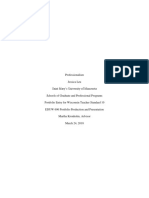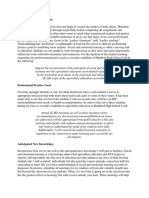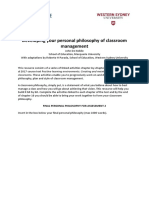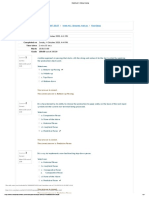Larsen Feap Goals
Larsen Feap Goals
Uploaded by
api-248291700Copyright:
Available Formats
Larsen Feap Goals
Larsen Feap Goals
Uploaded by
api-248291700Original Title
Copyright
Available Formats
Share this document
Did you find this document useful?
Is this content inappropriate?
Copyright:
Available Formats
Larsen Feap Goals
Larsen Feap Goals
Uploaded by
api-248291700Copyright:
Available Formats
Brittaney Larsen FEAP goals Spring 2014
1. INSTRUCTIONAL DESIGN & LESSON PLANNING
Applying concepts from human development and learning theories, the effective educator consistently:
c. Designs instruction for students to achieve mastery; e. Uses a variety of data, independently, and in collaboration with colleagues, to evaluate learning outcomes, adjust planning and continuously improve the effectiveness of the lessons; and f. Develops learning experiences that require students to demonstrate a variety of applicable skills and competencies. In my current field experience, I do many things that would go under this category. First, I would like to mention that I have started a reading group of students that are almost on level. Every week we focus on a certain skill and do a graphic organizer to gather our thoughts. Usually, whatever the focus is in shared is what we do in guided, but sometimes it may be different. The second thing I would like to mention is my work with making homework packets. When I make the packets, I look at each kid and try to see where he or she needs the most work. Some kids get extra math, and other get extra reading. Homework packets are differentiated and are tailored to each individual child. When I make the packets,
Brittaney Larsen FEAP goals Spring 2014
I do not really think about the process. Its just naturally differentiated in my brain and before today, I thought nothing of it.
2. LEARNING ENVIRONMENT
To maintain a student-centered learning environment that is safe, organized, equitable, flexible, inclusive, and collaborative, the effective educator consistently:
a. Organizes, allocates, and manages the resources of time, space, and attention; b. Manages individual and class behaviors through a well-planned management system; c. Conveys high expectations to all students; d. Respects students cultural, linguistic and family background; e. Models clear, acceptable oral and written communication skills; f. Maintains a climate of openness, inquiry, fairness and support; g. Integrates current information and communication technologies; h. Adapts the learning environment to accommodate the differing needs and diversity of students; and i. Utilizes current and emerging assistive technologies that enable students to participate in high-quality communication interactions and achieve their educational goals.
Brittaney Larsen FEAP goals Spring 2014
I have highlighted all of the goals in this section because I am doing things that deal with each and every one of these. I always convey high expectations to all of my students. I do a lot of management tasks such as lining the kids up and taking them to specials. This requires a lot of behavior management. Since I am new, some of the students do not take me seriously. However, I have recently started to move colors and take away tallies when necessary and now they are starting to see me as more of a teacher instead of an assistant. I have also begun doing read alouds every day before lunch and the kids love every minute of it. It doesnt matter what book I pick, they seem to love anything I read. In my opinion, the goals that I have made in this section hit home the hardest because they have a lot to do with working with the children. They are the main reason why I am here, so anything that helps me strengthen my connection with them is good with me.
5. CONTINUOUS PROFESSIONAL IMPROVEMENT
The effective educator consistently:
a. Designs purposeful professional goals to strengthen the effectiveness of instruction based on students needs; c. Collaborates with the home, school and larger communities to foster communication and to support student learning and continuous improvement;
Brittaney Larsen FEAP goals Spring 2014
d. Engages in targeted professional growth opportunities and reflective practices, both independently and in collaboration with colleagues; and e. Implements knowledge and skills learned in professional development in the teaching and learning process. For this section, I have decided to make sure I attend all PBS events, which require me taking a small group of students to an event with many other classes. It takes a lot of management because the students need to know the behavior that is expected of them at all times. We also talked about me attending a parent teacher conference night to see how my CT interacts with the parents in her class. It will be beneficial for me to see because that is not something you learn to do in a class. Also seeing how my CT records her interactions with the parents is vital because if a parent claims the teacher did not communicate with them, she has proof. I have started interacting with parents in the mornings, and it is a little bit nerve wrecking because they dont see me as a teacher. Lastly, I will continue to check binders and interact with parents that way as well.
6. PROFESSIONAL RESPONSIBILITY & ETHICAL CONDUCT
Brittaney Larsen FEAP goals Spring 2014
Understanding that educators are held to a high moral standard in a community, the effective educator adheres tothe Code of Ethics and the Principles of Professional Conduct of the Education Profession of Florida, pursuant to State Board of Education Rules 6B-1.001 and 6B-1.006, F.A.C, and fulfills the expected obligations to students, the public and the education profession. The goals in this category are ones that need to be fulfilled at all times. This includes but is not limited to: showing up on time, dressing professionally, going to PLC meetings, faculty meetings, and any reading trainings that my CT thinks I should attend. These are beneficial to attend because it teaches me about the behind the scenes work that teachers do.
You might also like
- HALL, Jonathan M. - Ethnic Identity in Greek Antiquity 1997 PDFDocument242 pagesHALL, Jonathan M. - Ethnic Identity in Greek Antiquity 1997 PDFr monpean100% (2)
- Danielsons Framework For TeachingDocument21 pagesDanielsons Framework For Teachingapi-302150632No ratings yet
- Session 1: Mandate, Vision. Mission. Core Values, and Strategic DirectionsDocument25 pagesSession 1: Mandate, Vision. Mission. Core Values, and Strategic DirectionsCabrina A. Torbeso100% (2)
- Year 1 Self-AssessmentDocument11 pagesYear 1 Self-Assessmentapi-221908465100% (2)
- FEAPs PortfolioDocument2 pagesFEAPs Portfoliochelsea2310No ratings yet
- Standard 4 RationaleDocument1 pageStandard 4 Rationaleapi-248126651No ratings yet
- LEDESMA - Reflection 1 - ED 214Document3 pagesLEDESMA - Reflection 1 - ED 214ledesma.shaineisabelNo ratings yet
- Maya Newell 42521336Document6 pagesMaya Newell 42521336api-296001398No ratings yet
- Midterm Final ReviewDocument10 pagesMidterm Final Reviewapi-579830025No ratings yet
- Presentation ReflectionDocument5 pagesPresentation Reflectionembry44No ratings yet
- KSC For PortflioDocument5 pagesKSC For Portflioapi-239660613No ratings yet
- Graduate KSC 2015Document4 pagesGraduate KSC 2015api-296342044No ratings yet
- Self-Assessment and Professional Learning Plan/resilienceDocument4 pagesSelf-Assessment and Professional Learning Plan/resilienceapi-315623968No ratings yet
- Goals For Ps IIIDocument4 pagesGoals For Ps IIIapi-239090309No ratings yet
- Capstone Yr 2Document13 pagesCapstone Yr 2api-216279960No ratings yet
- Summary OutputDocument5 pagesSummary Outputlapocmarivic6No ratings yet
- MD 5Document6 pagesMD 5api-618740462No ratings yet
- Veronica L. MontemayorDocument11 pagesVeronica L. Montemayorapi-357129937No ratings yet
- Wts 10 696Document25 pagesWts 10 696api-355629367No ratings yet
- Dale SelfdirectedgrowthDocument4 pagesDale Selfdirectedgrowthapi-356486727No ratings yet
- PPST Domains ReflectionDocument5 pagesPPST Domains ReflectionJARYL PILLAZAR100% (1)
- Feap 5 WeeblyDocument6 pagesFeap 5 Weeblyapi-531495599No ratings yet
- Rja Final CorrectDocument7 pagesRja Final CorrectTraci ThomasNo ratings yet
- Standards 4 (NAEYC-INI-2010.4) : Using Developmentally Effective Approaches Exhibit 1: Cultural Case Study DescriptionDocument7 pagesStandards 4 (NAEYC-INI-2010.4) : Using Developmentally Effective Approaches Exhibit 1: Cultural Case Study DescriptionImran BalochNo ratings yet
- P1 INTERVIEW QUESTIONSDocument5 pagesP1 INTERVIEW QUESTIONSlagretha1993No ratings yet
- Zimmer David - Psiii TPGP Final VersionDocument5 pagesZimmer David - Psiii TPGP Final Versionapi-329060283No ratings yet
- Fs 1Document17 pagesFs 1Jerico SimNo ratings yet
- PRT End of Year Report - Katie EverettDocument3 pagesPRT End of Year Report - Katie Everettapi-294861001100% (1)
- Final Feaps 3 CrawfordDocument2 pagesFinal Feaps 3 Crawfordapi-263387309No ratings yet
- Cspel 2 Narrative SummaryDocument5 pagesCspel 2 Narrative Summaryapi-377039370No ratings yet
- Narrative Reflections AssignmentsDocument6 pagesNarrative Reflections Assignmentsapi-245889774No ratings yet
- Teaching PlatformDocument8 pagesTeaching Platformapi-340158983No ratings yet
- Reflection Domain CDocument4 pagesReflection Domain Capi-296521478No ratings yet
- Growth PlanDocument2 pagesGrowth Planapi-276042567No ratings yet
- Professional Self 2 TashaDocument2 pagesProfessional Self 2 Tashaapi-282666593No ratings yet
- Statement of Informed BeliefsDocument11 pagesStatement of Informed Beliefsapi-511871470No ratings yet
- Clinical Field Experience C Planning Instructional UnitsDocument5 pagesClinical Field Experience C Planning Instructional UnitsKelly SchunkNo ratings yet
- M8A1: Signature Assignment: Classroom Management PhilosophyDocument7 pagesM8A1: Signature Assignment: Classroom Management PhilosophyD HoldenNo ratings yet
- Keyselection Criteria SampleDocument4 pagesKeyselection Criteria SampleBegumKarabatakNo ratings yet
- Self Evaluation 2017-2018 WareDocument3 pagesSelf Evaluation 2017-2018 Wareapi-358486974No ratings yet
- Module10 ActivityDocument4 pagesModule10 ActivityTitofelix GalletoNo ratings yet
- Assessment Learning IntentionsDocument4 pagesAssessment Learning Intentionsapi-313300251No ratings yet
- PORTFOLIO in FS2 2Document11 pagesPORTFOLIO in FS2 2marvin.calibusoNo ratings yet
- Literacy CafeDocument16 pagesLiteracy CafeKms SouthwickNo ratings yet
- Professional Development Responsibility LogDocument10 pagesProfessional Development Responsibility Logapi-247664759No ratings yet
- Data Board InquiryDocument16 pagesData Board InquirylynjonesNo ratings yet
- TPGP - September 10 17Document3 pagesTPGP - September 10 17api-336248078No ratings yet
- Teacher Leader Project CabralDocument17 pagesTeacher Leader Project Cabralapi-678707581No ratings yet
- Strathmore North KSCDocument7 pagesStrathmore North KSCapi-299102622No ratings yet
- W/C 15.12.14 Summative Review and Data Collection: G R A D e Targets ActionsDocument2 pagesW/C 15.12.14 Summative Review and Data Collection: G R A D e Targets Actionsapi-286214424No ratings yet
- Final Reflective Blog PostDocument3 pagesFinal Reflective Blog Postapi-526252514No ratings yet
- interview questionsDocument6 pagesinterview questionsMhaimhai-Wewe Tejadillo-Jimenez Reyes-OconNo ratings yet
- g12 Module 6 Reaffirming the Chosen TrackDocument10 pagesg12 Module 6 Reaffirming the Chosen TracklunawasabiluneNo ratings yet
- My Practicum ExperienceDocument3 pagesMy Practicum Experienceapi-401842503100% (1)
- Villanueva, Jessica d. -SummaryDocument14 pagesVillanueva, Jessica d. -SummaryjdvillanuevafacultyNo ratings yet
- Teacher Professional Growth Plan 2014Document3 pagesTeacher Professional Growth Plan 2014api-238204144No ratings yet
- Murray C Educ4001 Assessment3Document5 pagesMurray C Educ4001 Assessment3api-312990091No ratings yet
- Module 1 FinalDocument43 pagesModule 1 FinalViktor InocNo ratings yet
- Psiii Final ReportDocument9 pagesPsiii Final Reportapi-237958130No ratings yet
- Unit 102082 Philosophy of Classroom Management Document R 2h2017Document19 pagesUnit 102082 Philosophy of Classroom Management Document R 2h2017api-357575377No ratings yet
- Important Prayer Principles Important Prayer PrinciplesDocument7 pagesImportant Prayer Principles Important Prayer PrinciplesnicethoughtsNo ratings yet
- Erika AssessmentDocument4 pagesErika Assessmentjoey catotoNo ratings yet
- LWD MWD AnadrillDocument38 pagesLWD MWD AnadrillJose SantiagoNo ratings yet
- Oceanography Class NotesDocument142 pagesOceanography Class Notesamanamu436No ratings yet
- Pearlbrook Rules (WEB)Document8 pagesPearlbrook Rules (WEB)Unoque NoesyoNo ratings yet
- 550wordsDocument3 pages550wordsJin JinNo ratings yet
- 3 Preparation of SleepersDocument15 pages3 Preparation of SleepersMourya Teja VuddandiNo ratings yet
- Interactive Study Plan AAADocument96 pagesInteractive Study Plan AAAFahad Ahmad KhanNo ratings yet
- 3.1 Organic and Inorganic Molecules: Chelsea Pan, Lucy Tang, Samantha Xing Chapter 3 Macromolecules PD 2Document4 pages3.1 Organic and Inorganic Molecules: Chelsea Pan, Lucy Tang, Samantha Xing Chapter 3 Macromolecules PD 2Sam MonellaNo ratings yet
- Inclusion-Exclusion and Special Numbers: Theorem 1 (Inclusion-Exclusion Principle) - For Any Collection (ADocument8 pagesInclusion-Exclusion and Special Numbers: Theorem 1 (Inclusion-Exclusion Principle) - For Any Collection (ABil MafrouchNo ratings yet
- CHAPTER 6 Online QuizDocument12 pagesCHAPTER 6 Online Quizေဟ မိုးဆက္No ratings yet
- Malaysia Final Examination: UniversitiDocument8 pagesMalaysia Final Examination: UniversitiIzzat Khair Bin MahmudNo ratings yet
- Pps Fold (1) - 1Document23 pagesPps Fold (1) - 1srilikki16No ratings yet
- ETM7172 Power & BW BudgetDocument57 pagesETM7172 Power & BW BudgetHyung Nara100% (1)
- Help Line 1912 Electricity Department - Government of Goa: Current Demand Calculation Details Present Bill ChargesDocument1 pageHelp Line 1912 Electricity Department - Government of Goa: Current Demand Calculation Details Present Bill ChargesSatkar GarmentNo ratings yet
- Department of Chemical Engg. ASSIGNMENT-3, Mass Transfer IDocument3 pagesDepartment of Chemical Engg. ASSIGNMENT-3, Mass Transfer IKimberly BautistaNo ratings yet
- Dyslexic Children: The Need For Parents AwarenessDocument9 pagesDyslexic Children: The Need For Parents AwarenessJoi JenozNo ratings yet
- Linvakri's Guide To SyrkarnDocument112 pagesLinvakri's Guide To SyrkarnJackson DunlayNo ratings yet
- Practice Test Mathematics 8 ADocument4 pagesPractice Test Mathematics 8 AGeorgia Grace GuarinNo ratings yet
- Week2 DLL EnglishDocument8 pagesWeek2 DLL EnglishMa Michelle FranciscoNo ratings yet
- Cavitation and Water Hammer PDFDocument22 pagesCavitation and Water Hammer PDFsumeghNo ratings yet
- Strongly Disagree Disagree Neutral Agree Strongly AgreeDocument3 pagesStrongly Disagree Disagree Neutral Agree Strongly AgreeHafsah Ahmad najibNo ratings yet
- MBA Healthcare ManagementDocument6 pagesMBA Healthcare ManagementBalaji VNo ratings yet
- Format 2 Minor Test-3 11th Sip, Sankalp 1,2,3,4,5 Antares 1,2,3Document10 pagesFormat 2 Minor Test-3 11th Sip, Sankalp 1,2,3,4,5 Antares 1,2,3shub94223No ratings yet
- Tingkat Pengetahuan Kesehatan Reproduksi Dengan Tingkat Kesiapan Menghadapi MenarcheDocument9 pagesTingkat Pengetahuan Kesehatan Reproduksi Dengan Tingkat Kesiapan Menghadapi MenarchetitinNo ratings yet
- 1500 ForcedMatesDocument13 pages1500 ForcedMatesRamesh Babu0% (1)
- Choral Organ Awards Booklet 1Document42 pagesChoral Organ Awards Booklet 1M. LorenzoNo ratings yet
- Programming Languages With Compiler FQuiz 1 PDFDocument3 pagesProgramming Languages With Compiler FQuiz 1 PDFJr CialanaNo ratings yet
- Voice Change Following Testosterone SupplementationDocument7 pagesVoice Change Following Testosterone SupplementationClaudia TorresNo ratings yet

























































































